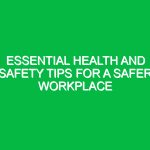Welcome, team! Today, we’re going to discuss an essential topic that is crucial for our safety and well-being on the job – Heavy Equipment (Four Other Hazards). It’s vital that we understand the risks associated with heavy equipment and other hazards in our work environment to prevent accidents and ensure a safe work environment for everyone. Let’s dive into the details and learn how to protect ourselves and our team.
The Importance of Heavy Equipment Safety
Heavy equipment such as cranes, bulldozers, excavators, and forklifts are commonly used in our daily operations. While these machines are essential for getting the job done efficiently, they also pose significant risks if not handled properly. Accidents involving heavy equipment can result in serious injuries or even fatalities, which is why it’s crucial to prioritize safety at all times.
Four Other HSE Hazards
In addition to heavy equipment, there are four other common hazards in the workplace that we need to be aware of:
- 1. Fall Hazards
- 2. Electrical Hazards
- 3. Hazardous Materials
- 4. Fire Hazards
Each of these hazards presents unique risks that we must address to maintain a safe working environment. Let’s explore each of them in more detail:
Fall Hazards
Falls are a leading cause of workplace injuries, particularly in construction and industrial settings. To prevent falls, always use fall protection equipment when working at heights, ensure that ladders are secure before use, and keep work areas free of clutter or obstacles that could cause tripping.
Electrical Hazards
Electrical hazards can be lethal if not properly managed. Always follow proper lockout/tagout procedures when working on electrical equipment, never overload outlets, and report any damaged or frayed cords immediately to prevent electrical accidents.
Hazardous Materials
Handling hazardous materials requires caution and proper training. Always wear appropriate personal protective equipment when working with chemicals, follow safety data sheets for handling and storage instructions, and report any spills or leaks promptly to prevent exposure.
Fire Hazards
Fire hazards can quickly escalate if not addressed promptly. Keep fire exits clear at all times, store flammable materials in designated areas away from ignition sources, and participate in fire drills to ensure everyone knows how to respond in case of a fire emergency.
Best Practices for Heavy Equipment Safety
Now that we’ve covered the common hazards in our workplace, let’s focus on best practices for heavy equipment safety:
- Training: Ensure all operators are properly trained and certified to operate heavy equipment.
- Maintenance: Regularly inspect and maintain equipment to prevent breakdowns and malfunctions.
- Communication: Establish clear communication protocols between operators and ground personnel to avoid accidents.
- Visibility: Use spotters or backup cameras to enhance visibility around heavy equipment.
Regulations and Standards
It’s essential to comply with all relevant regulations and standards related to heavy equipment and workplace hazards. By following these guidelines, we not only ensure our safety but also fulfill legal obligations that protect us and our team members.
Conclusion
Remember, our safety is in our hands. By understanding and mitigating the risks associated with heavy equipment and other workplace hazards, we can create a safer and more productive work environment for everyone. Let’s stay vigilant, communicate effectively, and prioritize safety in everything we do. Thank you for your attention, and let’s work together to protect our team!


